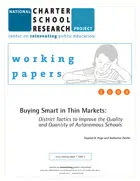No Child Left Behind has heightened pressure on school districts to offer quality options for every child. In response, some cities have sought to expand the number of autonomous schools (whether governed by charter or contract). Yet districts face a “thin” market: quality providers are hard to find.
Economic theory suggests four general approaches to building supply: streamlining regulations, building the capacity of providers, rewarding quality and reducing risk. The authors find that districts do in fact use these approaches, though their level of aggressiveness varies. Moreover, in general, the districts appear more focused on streamlining regulations and rewarding quality than on building capacity and reducing risk.
District action is constrained by both prevailing norms and real costs of investment. Given this reality, flexibility may be an asset. To the extent that a tradeoff exists between reducing risk and preserving organizational autonomy, districts that enable providers to choose one of multiple bundles of freedoms and services may be able to expand their pool of potential providers.




